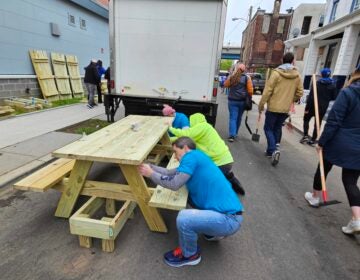Walnut Lane Bridge slated for six-month closure in 2014
Speaking to a standing-room-only crowd, Michael Cuddy explained to those gathered at the Blue Bell Hill Civic Association meeting that the Walnut Lane Bridge, slated for closure in 2014, is unique in its architecture, utilizing an open spandrel concrete arch design, with the concrete unreinforced by steel beams.
Testing their knowledge, Cuddy asked how many bridges across the globe utilized the same design. Receiving a handful of haphazard responses, he provided those in attendance with the correct answer: Two, with the other being located in Europe, upon which the Walnut Lane Bridge, built in 1908, was modeled.
In response, someone asked pointedly, “Are you closing that one next year?”
A two-phase approach
When the laughter subsided, attention turned again to the $7 million overhaul of the historic Walnut Lane Bridge. The plan consists of removing and replacing the bridge’s half-mile roadway, improving lighting and signage, and repairing drainage systems and eroded slopes beneath the bridge.
Cuddy, project manager with TranSystems, which is directing the design for PennDOT, provided updated design timelines for the bridge on Tuesday night’s BBHCA meeting, and responded to community concerns about its projected impact on residents. At present, the design stage will continue through the end of 2013, with work on the bridge slated to begin in the spring of 2014.
Work on the bridge will occur in two phases: The first phase, which includes the bridge’s closure, will run for approximately six months. Cuddy noted that this was a conservative estimate, with incentives included for the contractor for timely completion. The second phase will see the reopening of the bridge to traffic, with repairs to the bridge’s underside and sidewalks taking place.
The project is scheduled to conclude in 2015.
While an estimated timeline is in place, the projected vehicular impact of the project remains in dispute. As reported by NewsWorks in April, Cuddy related that 16,000 vehicles a day cross the bridge, taking a 3.5-mile long detour along Wissahickon, Midvale, and Henry avenues.
On Tuesday night, Cuddy estimated the traffic count at approximately 9,500 vehicles. Asked to explain or verify the difference, Cuddy did not provide a definitive response – other PennDOT officials present suggested it was the difference between local and regional bridge users – but offered a general characterization of the traffic count.
“It’s a lot of cars,” he said.
Restoring and preserving the bridge
Describing the bridge itself, Cuddy said that it is in fair condition overall. While concrete pieces are falling away onto trails 150 feet below, in terms of its load carrying capacity, the bridge is structurally sound. As such, he described the project as being a restoration and preservation program.
Providing specifics, he observed that 11 inches of cinders used to fill unrealized trolley tracks along the bridge’s center have become waterlogged over the years, and need to be removed.
Steel floor beams have also started to rust as a result of water infiltration, and while the rust is minimal, left unchecked, the beams could have negative implications on the bridge’s soundness.
One area that has seen extensive deterioration is in the cantilever brackets that support the sidewalls of the bridge. Of the 178 brackets present, Cuddy said 55-percent are in need of replacement.
The upshot is that the removal of the ash and seven inches of asphalt on the bridge’s deck will result in a reduction in the dead load of the bridge, ensuring that the rehabilitated bridge will continue to be structurally sound well into the future.
However, Cuddy said that the removal of the ash and its support structure will preclude a partial closure of the bridge, despite the hopes of many in attendance.
The impact on traffic
Turning his attention to community concerns, Cuddy reiterated earlier statements made by PennDOT, indicating that the bridge would be closed for the shortest duration possible in an attempt to balance traffic impact with the needs of the project.
While reminding those in attendance that the six month closure was a conservative estimate – it could take less time – he said that pedestrian access will be available throughout the duration of the project, as will access to Forbidden Drive. Notifications to the police and fire departments will also be forthcoming.
Contrary to rumor, city plans to rehab portions of Lincoln Drive will not take place within the timeframe of the Walnut Lane Bridge project.
Speaking for traffic planning, Charles Denny, chief engineer for the Streets Department, said that much of the traffic volume headed northbound will be absorbed by Rt.1 and Hunting Park Ave. Responding to inquiries about the potential for Valley Green Rd. as a detour, Denny said that the road and connecting bridges are not suitable for through traffic.
Denny said this his department will look into signaling along the detour routes to accommodate increased traffic flow, but predicted that traffic will “spread out” in an organic fashion, and suggested that motorists explore public transit alternatives.
Speaking for SEPTA, Constituent Relations Coordinator Wendy Green Harvey provided details about her agency’s plans to handle the closure.
The Route 65 bus, which crosses the bridge in both directions approximately 70 times a day, will be detoured along Midvale and Henry avenues. Asked by residents if there were plans to add additional train service, Harvey said she would need to consult with Regional Rail officials to assess the possibility, but speculated that additional cars would only be added during peak hour trains.
Mixed reaction
John Dixon, chair of the BBHCA’s committee on the bridge, expressed exasperation at the meeting, describing the public cost as “unreal,” citing wasted time and gas and potential impacts on businesses in Roxborough and Manayunk.
Contrasting Dixon’s sentiments, several in attendance were overheard expressing acceptance of the plan after the meeting.
Sidney Ozer, a BBHCA board member, said he was “receptive” to the plan, noting the reduced timeframe of the closure, which he said was originally as long as 12 to 14 months.
Ron Goldwyn, president of the BBHCA, indicated an interest in forming a working group with other community and business stakeholders in the bridge’s construction.
“I’m not sure that we’ve heard the last word on citizen input here tonight,” he said.
WHYY is your source for fact-based, in-depth journalism and information. As a nonprofit organization, we rely on financial support from readers like you. Please give today.




